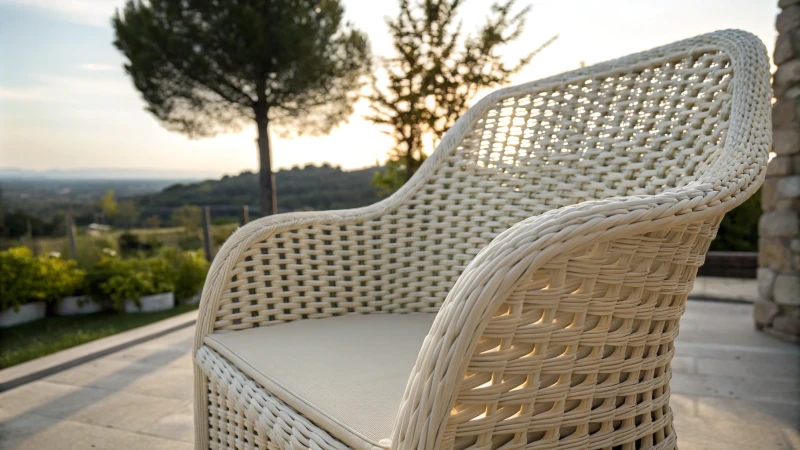
Did you ever think about how that lovely plastic rattan furniture got created?
Plastic rattan, also called resin wicker, begins with a special method. Workers extrude high-density polyethylene (HDPE) into long strands. These strands are then woven into strong, weather-resistant furniture. This blog provides guidance on each step of its production. It shows the benefits of plastic rattan.
Read more to explore the details of this manufacturing process. Learn why plastic rattan holds advantages over natural options.
I remember my first time seeing plastic rattan. This happened at a charming café outside. Plants and comfy chairs surrounded me. The furniture looked like real rattan but felt much stronger! My curiosity grew and I wanted to learn more about its creation. The makers start with high-density polyethylene (HDPE). They stretch it into long strands. Then, they weave these strands together. This method is fascinating. It creates durable items. It also brings an eco-friendly twist to modern design. This is really interesting!
Plastic rattan is made from high-density polyethylene (HDPE).True
Plastic rattan is manufactured using HDPE, which ensures durability and weather resistance.
Natural rattan is more durable than plastic rattan.False
Plastic rattan offers greater durability and weather resistance compared to natural rattan.
What are the key materials used in plastic rattan production?
Interested in the materials that create plastic rattan? Dive into the world of outdoor furniture. Learn how these materials add style and durability. These elements not only enhance beauty but also strengthen the furniture.
Plastic rattan production mainly uses polyethylene (PE), polyvinyl chloride (PVC) and polypropylene (PP). These materials are strong and last a long time. They can withstand different weather conditions. They also look good. This is why they are perfect for outdoor furniture. Outdoor furniture greatly benefits from these materials.
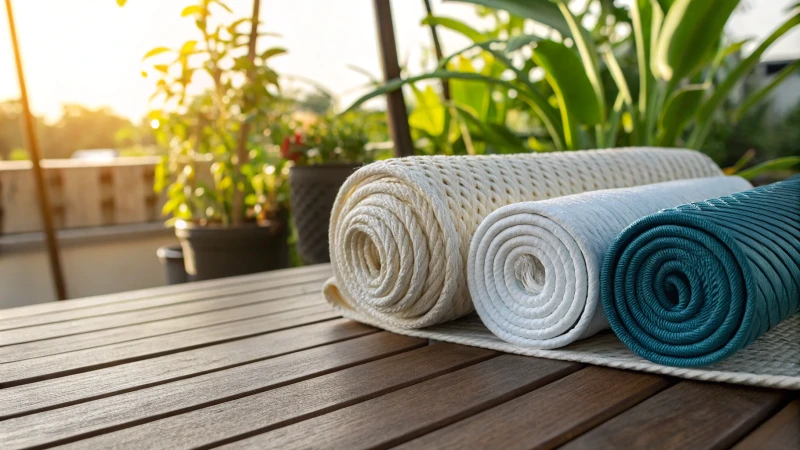
Understanding Plastic Rattan
I remember the first time I saw a beautiful outdoor set of plastic rattan. It was at my friend’s backyard party. The sun shone brightly and we all laughed together. The furniture looked so inviting. I was surprised to learn it was made from synthetic fibers that look like natural rattan. Its strength amazed me. Real rattan may suffer under hot sun, but plastic rattan stays strong. This mix of beauty and durability really impressed me. It stole my heart!
Key Materials Used in Plastic Rattan Production
While exploring plastic rattan, I found three key materials used in its production:
| Material | Description |
|---|---|
| Polyethylene (PE) | A lightweight, flexible polymer that is highly resistant to moisture and UV rays, making it ideal for outdoor use. It provides durability without sacrificing comfort. Learn more about PE1. |
| Polyvinyl Chloride (PVC) | Known for its strength and resistance to environmental factors, PVC is often used in the production of plastic rattan to enhance its structural integrity. It’s also cost-effective and versatile. Discover PVC uses2. |
| Polypropylene (PP) | This polymer offers excellent resistance to fatigue and chemicals, which contributes to the longevity of plastic rattan products. It’s commonly used for its lightweight properties and strength. Explore PP benefits3. |
These materials are not just parts; they help our plastic rattan furniture survive nature’s challenges and still look great.
Manufacturing Process Insights
I enjoy learning how things come to life, so discovering how plastic rattan is made was a joy:
- Extrusion: This step feels magical! Raw materials heat and form the well-known rattan-like strands.
- Coloring: Creativity shines here! Dyes add during extrusion, creating a rainbow of colors to fit any design.
- Weaving: Skilled hands weave the strands into patterns that remind us of traditional rattan and add beauty.
- Finishing: The last detail! After weaving, treatments improve UV resistance and durability, ensuring our furniture can look good for many years.
Reflecting on these steps, I think of Emily, our imaginary buyer who values quality and cares about the environment. By knowing these materials, she chooses pieces that match her style and last a long time.
The Importance of Material Selection
Choosing materials is like picking perfect recipe ingredients; it is crucial!
- Durability: Strong plastics like PE, PVC, and PP help our outdoor treasures last longer while reducing waste and the need for replacements.
- Sustainability: Many makers now use eco-friendly ways by utilizing recyclable materials and cutting waste in production—this is very important for mindful buyers like Emily.
By focusing on these materials and their special traits, sellers meet buyers wanting quality and sustainability. This knowledge empowers informed choices; investing in well-built outdoor furniture means investing in joyous times in nature.
For more information on sustainable practices in rattan production, check out sustainable rattan sourcing4.
Plastic rattan is made from natural rattan fibers.False
This claim is false; plastic rattan is produced from synthetic materials like PE, PVC, and PP, not natural rattan fibers.
Polyethylene enhances the durability of plastic rattan furniture.True
This claim is true; polyethylene provides moisture and UV resistance, contributing to the durability of plastic rattan products.
How does plastic rattan compare to natural rattan in terms of durability?
Choosing outdoor furniture might feel overwhelming. The decision between plastic and natural rattan is important for durability. These materials have different strengths. Understanding them helps choose the best fit.
Plastic rattan lasts longer than natural rattan, especially in bad weather. It defends against UV rays and moisture really well. Natural rattan needs more upkeep to stop it from wearing out.
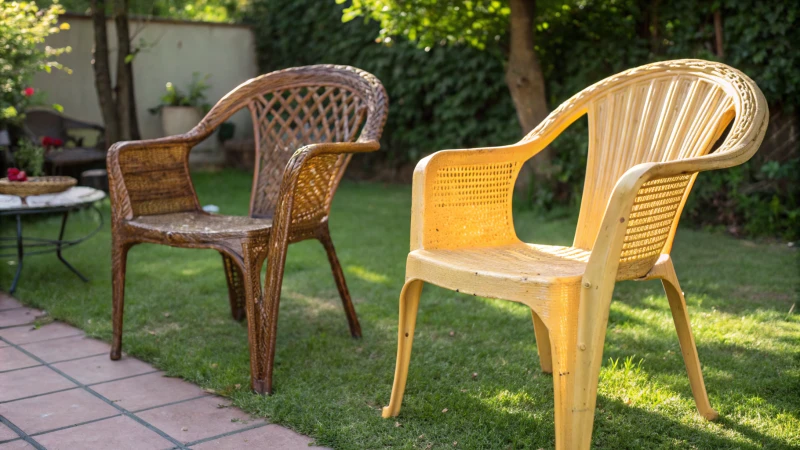
Understanding the Basics of Rattan Materials
When I started checking out outdoor furniture, rattan caught my eye. There are two types: natural and synthetic. Plastic rattan, also known as synthetic rattan or resin wicker, is made from high-density polyethylene (HDPE) fibers that are designed to mimic the appearance of natural rattan. It looks like natural rattan but is very strong. Natural rattan, on the other hand, comes from a palm plant and feels genuine and timeless.
As I learned more, each material showed its own special features. These features affect how long they last. Everyone, like Emily, needs to know these to pick wisely for their home.
Durability in Different Weather Conditions
Thinking about my experiences with outdoor furniture, it is important to consider the weather. Here’s a comparison of how each material performs:
| Condition | Plastic Rattan | Natural Rattan |
|---|---|---|
| UV Exposure | Highly resistant; retains color and integrity even under sunlight. | Prone to fading and degrading if not treated with protective coatings. |
| Moisture Resistance | Waterproof; does not absorb water, making it suitable for wet environments. | Absorbs moisture; can lead to mold and mildew growth if not properly dried. |
| Temperature Fluctuations | Can withstand extreme temperatures without warping or cracking. | Sensitive to temperature changes; can become brittle in extreme cold. |
This table highlights plastic rattan’s great strength in various conditions, making it a more practical choice for outdoor settings.
Maintenance Requirements
Natural rattan needs a lot of care. It feels like looking after a relationship! Regular cleaning stops mold growth by preventing moisture accumulation.
- Regular cleaning stops mold.
- Applying protective finishes guards against UV rays.
- Storing indoors during bad weather prolongs its life.
In contrast, plastic rattan is simple to look after. A quick wipe with a damp cloth is enough; this easy-care quality attracts people like me who want convenience in outdoor spaces.
Longevity and Wear Resistance
Plastic rattan usually lasts longer than natural rattan when exposed to outdoor elements. Natural rattan could survive 5 to 10 years with care, whereas plastic rattan shines for 15 years or more based on its quality. For those like Emily who value longevity, this longer life is crucial—it really influences their buying decision.
More insights on this topic can be found here5.
Cost Considerations
While plastic rattan might seem more expensive at first glance, its long life and easy care can save money over time. Here’s a quick comparison of expected costs:
| Material Type | Initial Cost | Average Lifespan | Maintenance Cost |
|---|---|---|---|
| Plastic Rattan | Higher | 15+ years | Low |
| Natural Rattan | Lower | 5-10 years | High |
This financial perspective is crucial for consumers wanting both style and practicality in their purchases.
Plastic rattan lasts longer than natural rattan outdoors.True
Plastic rattan can last over 15 years, while natural rattan lasts 5-10 years with care.
Natural rattan is more resistant to UV damage than plastic rattan.False
Natural rattan is prone to fading and degrading under UV exposure without protective treatments.
What are the environmental impacts of using plastic rattan?
When I first saw plastic rattan, I felt very drawn to its modern look. But as I learned more, I found many environmental issues that really made me question my decisions. What are the true environmental effects of this man-made option?
Plastic rattan harms the environment in several ways. It produces high carbon emissions during manufacturing. It does not break down naturally. It might release toxic chemicals. Recycling plastic rattan is difficult. Customers like me should think about these issues. This is important when choosing eco-friendly furniture.
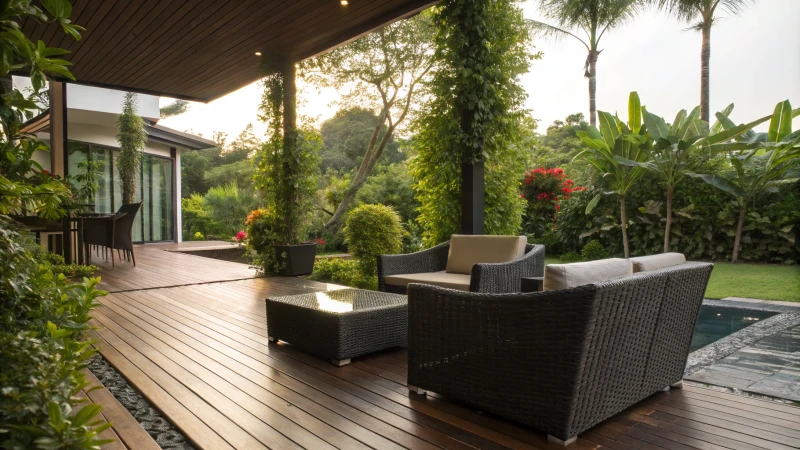
Understanding Plastic Rattan and Its Composition
The first time I saw plastic rattan furniture was at a friend’s outdoor party. The bright colors and modern designs caught my eye. I later learned this synthetic material, often created from high-density polyethylene (HDPE) or polypropylene, imitates natural rattan’s look. It offers durability and resists weather well. But this beauty hides some drawbacks and I began to wonder about its true environmental impact.
Plastic rattan’s long life can be attractive, but I realized production is important. Transforming raw petroleum into that stylish chair involves a lot of extraction and processing. These processes probably release significant carbon emissions. Chemicals used in manufacturing can harm workers and our beautiful planet. Learning about this material’s lifecycle showed me why informed choices matter when buying outdoor furniture and home decor.
Environmental Impacts of Production
Producing plastic rattan has several environmental challenges:
| Impact Area | Description |
|---|---|
| Carbon Emissions | High emissions from fossil fuel extraction and processing |
| Chemical Pollution | Use of toxic chemicals in production processes |
| Resource Depletion | Consumption of non-renewable resources |
Understanding these challenges is essential for those of us trying to reduce our ecological footprint. If you care about sustainability like I do, exploring sustainable production methods6 gives valuable insights for better choices.
Longevity vs. Disposal Concerns
Durability is a major advantage of plastic rattan, often outlasting natural materials. However, its durability creates problems when it’s time to dispose of it. I was surprised to find out most synthetic rattan doesn’t biodegrade and stays in landfills for centuries.
Breaking down, plastic rattan contributes to microplastic pollution. This is a serious issue threatening marine life and ecosystems. Thinking about our planet’s future and the legacy we leave is important to me.
- Did you know? Microplastics are found in ocean waters, affecting marine life and food chains. Curious? Read about microplastic pollution7.
Toxicity and Health Concerns
Exploring plastic rattan’s health risks, I found some synthetic materials might release volatile organic compounds (VOCs) into the air. This concerns me, especially when used indoors. It showed me the importance of being careful with indoor items.
- Key Point: Check for certifications showing low emissions or eco-friendly production practices. Learn more about certifications for safe materials8.
Recycling and End-of-Life Options
Recycling plastic rattan varies depending on local waste management rules. Some places recycle HDPE or polypropylene, but many do not, increasing landfill waste. Understanding local recycling abilities empowers us to make better consumer choices.
- Tip: Before throwing away old plastic rattan, learn how to recycle or repurpose it. Explore recycling options for synthetic materials9.
Overall, I appreciate plastic rattan’s benefits – like durability and easy maintenance – but cannot ignore its environmental impacts. Buyers like us must balance these factors with our values on sustainability and eco-friendliness. Informed decisions are not only about aesthetics; they contribute positively to our planet’s future.
Plastic rattan is made from sustainable materials.False
Plastic rattan is primarily made from HDPE or polypropylene, which are petroleum-based and not sustainable.
Plastic rattan products can take hundreds of years to decompose.True
Due to their synthetic nature, plastic rattan items are non-biodegradable and persist in landfills for a long time.
How can I ensure the longevity of my plastic rattan products?
Have you ever thought about how to keep your plastic rattan furniture looking fresh and bright? You’re in luck! A few simple care routines will help. I’ve discovered that keeping your rattan pieces beautiful is much simpler than you think!
To keep plastic rattan products lasting long, regularly clean them with mild soap. Protect them from the weather and check them every season. These actions help your furniture look really nice for years.
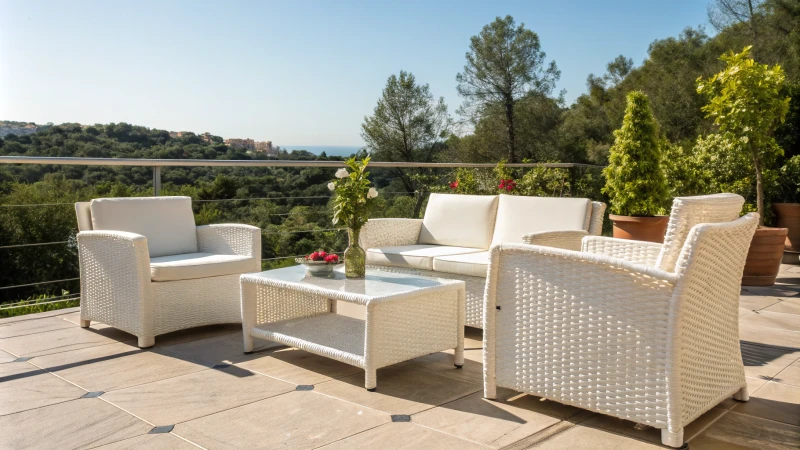
Understanding Plastic Rattan Products
When I first discovered plastic rattan, I was very impressed by its mix of style and strength. It is a fantastic option for outdoor furniture. Unlike natural rattan, plastic rattan struggles with moisture and pests, but it stands strong against weather. I remember a summer barbecue where my guests admired my stylish patio set. I felt proud knowing it would survive changing weather. Plastic rattan is truly strong and reliable.
Regular Cleaning Practices
To keep my plastic rattan looking nice, I follow a simple cleaning schedule:
| Frequency | Cleaning Method |
|---|---|
| Weekly | Wipe with a damp cloth or sponge. |
| Monthly | Use mild soap and water solution. |
| Seasonally | Deep clean with a soft brush. |
A soft brush10 helps me clean the small spaces in the weave. Trust me, rinsing well is important; I learned that leftover soap left my furniture looking dull, so I rinse thoroughly now.
Protective Measures Against Elements
Plastic rattan is tough, but a few extra steps really pay off:
- Covers: I use protective covers when my furniture isn’t in use to protect from UV rays and unexpected rain.
- Shade: I place my rattan furniture under shade if possible to avoid fading and keep it vibrant for years.
Seasonal Maintenance Tips
Each new season, my rattan products have special needs:
- Winter: I store my furniture indoors if I can; otherwise, I cover it to stay safe from frost and snow.
- Summer: I regularly check for wear or fading and consider using a UV spray for plastic materials.
Conclusion: Why Maintenance Matters
Taking time to care for my plastic rattan makes it last longer and keeps it beautiful. A little attention can transform furniture into a stylish focal point; I’ve seen this happen! If you want to learn more about care techniques, look at our guide on maintaining synthetic materials. I hope these tips inspire you to care for your plastic rattan!
Plastic rattan is resistant to moisture and pests.True
Plastic rattan does not absorb moisture and is not prone to pest damage, unlike natural rattan, enhancing its suitability for outdoor use.
Covers are unnecessary for protecting plastic rattan furniture.False
Using protective covers is essential to shield plastic rattan from UV rays and rain, prolonging its lifespan and maintaining appearance.
Conclusion
Discover how plastic rattan is made from HDPE, its benefits over natural rattan, and tips for maintenance to enhance longevity and sustainability.
-
This link will provide insights into the specific polymers used in plastic rattan production, enriching your understanding of material choices. ↩
-
Learn about the benefits of PVC in outdoor furniture production, including its durability and cost-effectiveness. ↩
-
Explore how polypropylene contributes to the longevity of plastic rattan products and its applications in furniture design. ↩
-
This resource discusses sustainable practices in sourcing materials for rattan products, aligning with eco-conscious consumer demands. ↩
-
Discover insights on rattan materials that will aid your purchasing decisions regarding durability and maintenance. ↩
-
Explore the ecological effects of plastic rattan to make informed purchasing decisions that align with your sustainability values. ↩
-
Learn about the challenges associated with plastic rattan disposal and what you can do to minimize your environmental footprint. ↩
-
Discover certifications that ensure safe production practices and low emissions in synthetic materials. ↩
-
Find out how to properly recycle plastic rattan products to reduce waste and support sustainability. ↩
-
Explore expert recommendations on maintaining your plastic rattan products effectively to maximize their lifespan. ↩

